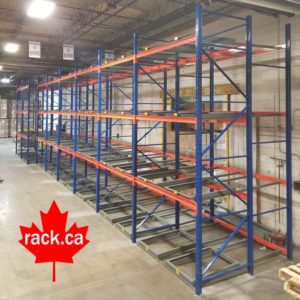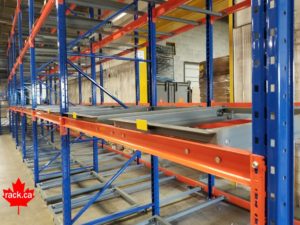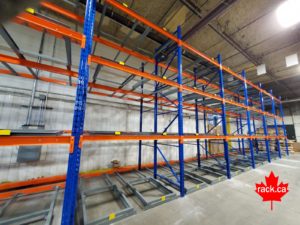What Is a Pushback Pallet Rack System?
Pushback pallets are classified as FILO (first in, last out). That’s because the first pallet that’s placed in the storage bay is pushed toward the back of the racking system with the subsequent pallet and so forth. Hence, items that are placed first in the storage bay are pushed toward the back and stored there once all of the products on the other pallets have been exhausted. Pushback pallets are commonly used in the warehouse, distribution, manufacturing, and supply chain industries because they have an unmatched storage and weight capacity that hold a variety of product types and shapes. The open design means products are safely accessible from all sides.
There are two main types of pushback pallet racking systems:
- Pushback with shuttles. Pallets are placed on shuttles, which are attached to rails on a slight incline. This makes it easy to slide the pallets back and forth as needed.
- Pushback with rollers. Pallets are placed on roller beds, which are secured to the structure and can be maneuvered back and forth as needed.
Whichever type you use, pushback pallet racking systems provide high density storage solutions that can maximize space and accessibility in your facility.
Important Features of Pushback Pallet Racking Systems
Increased Versatility
The great thing about pushback Pushback racking systems is that they’re not necessarily standalone storage solutions. When combined with other storage solutions like cantilever or carton flow racks, they can maximize storage space, organization, traffic flow, and accessibility in your facility.
Maximum Accessibility
Pushback pallet racking systems also increase work flow and productivity. More pallets can be stored without sacrificing pallet selectivity. Pushback pallet racking systems provide a high density storage solution that allows for smoother pallet racking maneuvering. SKUs that are placed at the front of the bay are the last to be loaded and the first to be unloaded. These are typically high-demand items that need to be shipped out as quickly as possible, whereas items that are placed toward the back can be stored for longer periods of time. This rotational system allows for great accessibility in wide aisles as forklift operators have more space to move around safely.
Limited Channel Depth
Pushback pallets are compatible with all types of material-handling equipment, including narrow-aisle, cherry pickers, swing reach, and counterbalance forklifts. Multiple pallets containing the same SKUs can be stored on pushback pallet racking systems. Depending on the weight, quantity requirements, and space availability of the storage facility, pushback pallet racking systems can hold anywhere between two to five pallets at any given time. Lift pallets never have to enter into the storage area, which limits the amount of contact-based damage from material-handling equipment.
High Picking Productivity
Forklift drivers can easily and safely pick and unload items from pushback pallet racking systems. Since each bay typically contains items with the same SKUs, it doesn’t really matter which products are unloaded first. Perishable products can be organized and stored according to best before or expiry dates to reduce waste and ensure that all products are shipped in a timely manner.
Low Labour Risks
Minimal physical labour is required on the part of warehouse and supply chain workers, which can makes their jobs safer, a little easier, and increases efficiency in the workplace. Pushback pallet racking systems eliminate the burden of storage disorganization and overcrowding a single pallet, which removes the possibility of obstructions when it’s time to unload pallets. Pushback pallet racking systems can also be customized according the size, layout, and infrastructure of your facility to ensure seamless installation, maintenance, and usage that minimizes physical strain for warehouse workers.
How Pushback Pallet Racking Works
Low Profile Design
Pushback pallet racking systems typically have a low profile design, which is common for cart-type racking systems. Low profile designs allow more room for additional clearance, so that you can expand your racking system as your product and pallet racking storage needs evolve over time.
Linked Carts
Pushback pallet racking systems consist of carts that are linked together on a slightly inclined slope to allow for easy maneuvering and safe movement in and out of the lane. Linking the carts together prevents a single cart from obstructing the backend of the lane and makes it easier to retrieve the last pallet when it’s time to unload. It also prevents one of the pallets from becoming dislodged, released from the mechanism, and falling off the pallet. Essentially, linking the carts together ensures that they’re completely secured into place and reduces potential product damages, financial losses, and workplace injuries.
Multi-Purpose Safety Stop
Pushback pallet racking systems have another important feature: a multi-purpose safety stop that’s located at the bottom of every cart. As the name suggests, the safety stop serves a number of purposes. It indicates when a lane has reached maximum capacity and no more pallets can be deposited on it and it keeps pallets that are on carts from shifting forward, backward, or sideways by essentially locking them into place.
Low-Cost Installation
Modular pushback pallet racking storage systems are incredibly easy to install and maintain. According to the Occupational Health and Safety Act (OHSA) in Ontario, all employers in industrial sectors are responsible for ensuring the safe operation and condition of pallet racking systems and material handling equipment. Pre-Start Health and Safety Reviews (PSRs) are typically required for newly installed pallet racking systems and should be performed by licensed engineers. The only exemption is in cases where the employer provides documentation proving that the design and installation of the structure is in compliance with “current standards”.
Get High-Quality Pushback Storage Racks in Ontario
For over 25 years, Canadian Rack Technologies Inc. has maintained a strong reputation as being one of the leading distributors of brand-name high-quality pallet racking systems in Toronto, Mississauga, and throughout the GTA. Our areas of expertise include safety inspections, safety products, pallet storage products, industrial shelving, performing PSRs, and so much more. Contact us to discuss your pallet racking needs in Ontario today.



